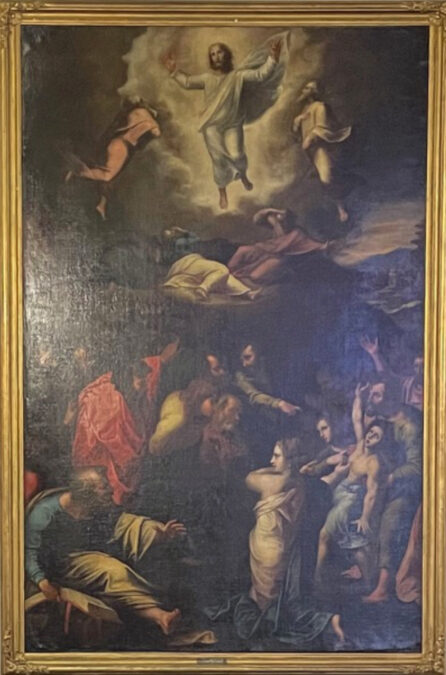Raphael's 'Transfiguration'

The “Transfiguration” is the last painting by the Italian High Renaissance master Raphael commissioned by Cardinal Giulio de Medici, the later Pope Clement Vll (1523-1534) and conceived as an altarpiece for the Narbonne Cathedral in France. Raphael worked on it until his death in 1520. The Original now hangs in the Pinacoteca Vaticana in Vatican City.
Moses and Eljah appear before the transfigured Christ with Peter, James, and John looking on. The two figures kneeling on the left are Justus and Pastor who were the patron saints of Medici’s archbishopric and the cathedral for which the painting was intended.
The upper portion of the painting includes from left to right, James, Peter and John, traditionally symbols of faith, hope and love, hence the symbolic colors, yellow, green and red for their robes.
In the lower portion of the painting, Raphael depicts the Apostles attempting to free a possessed boy of his demonic possession. They are unable to cure the sick child until the arrival of the recently transfigured Christ, who performs a miracle. The youth is no longer prostrate from his seizure but is standing on his feet, and his mouth is open, which signifies the departure of the demonic spirit.
The figure in the blue robe on the bottom left is probably Matthew. He consults a book but cannot find the solution to cure the young man. The young disciple in the yellow robe is Philip. To Philip’s right, in the red robe, is Andrew. The man behind Andrew, pointing to the sick boy, is Judas Thaddeus, and the older man to his left is Simon. The man on the far left is probably Judas Iscariot. The man behind the boy holding him is his father who is in the green robe. He looks at the disciples while pointing at the young man.
The kneeling woman in the lower foreground is set apart from either group; the disciples or the boy’s family. She kneels forming a compositional bridge between the two groups in a serpent’s pose in which her shoulders and hips move in opposition.
Simply stated, the painting can be interpreted as a contrast between the saving power and purity of Christ in the top half of the painting, with the flaws of Man, symbolised by the state of confusion in the bottom half of the painting.
The painting had been hung in the dining room at the diocese’s Bishopstead and was in storage when the Trustees offered the opportunity for a church in the diocese to acquire the painting. The dimensions are 78 ½” x 54” x 3 ½’. St. Paul’s Episcopal Church received the painting from the diocese in May of 2018.
This picture “Transfiguration”, is a replica of Raphael’s picture of the name, painted by one of Raphael’s pupils, Juliano Romano, and finished by the master himself. At one time it hung in the Roman Catholic Cathedral in Lima, Peru. During one of the many revolutions in Peru the Bishop sought refuge in the American Embassy bringing some of the Art Treasures from the cathedral with him. The Hon. John Randolph Clay, American Minister from 1847 to 1860 later purchased some of these pictures, this being among them and brought it to this country in 1860. He left it to his son Randolph Clay and I inherited it from him and presented it to Bishopstead in the summer of 1918. As my family and both of my husband’s were from Delaware I wanted it placed in this state.
Alice Clay Maclulich
Raphael 1483 – 1520
Giulio Romano 1490 – 1547
The painting is on loan to St. Paul’s Church for as long as St. Paul’s Church is in being by the Episcopal Church of Delaware.
